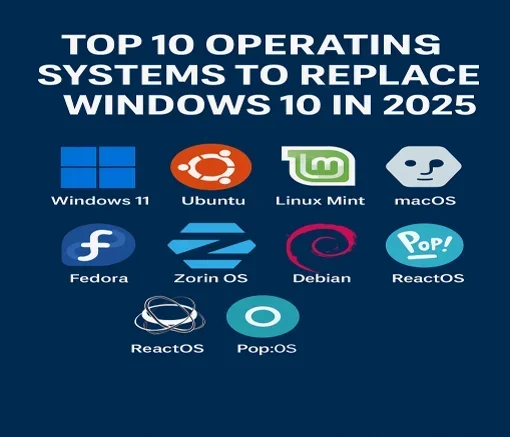As Windows 10 approaches its end-of-support date on October 14, 2025, millions of users worldwide face a critical decision: what comes next? With Microsoft discontinuing free security updates and technical support for Windows 10, upgrading to a new operating system (OS) is essential to maintain security, performance, and compatibility. While Windows 11 is a natural choice for some, its strict hardware requirements leave many PCs ineligible.
Fortunately, 2025 offers a diverse range of alternative operating systems that cater to various needs, from user-friendly interfaces to open-source flexibility. In this detailed and informative blog post, we explore the top 10 operating systems to replace Windows 10 in 2025, backed by the latest data from official sources, to help you make an informed choice.
Why Replace Windows 10 in 2025?
Before diving into the alternatives, let’s understand why replacing Windows 10 is crucial. As of July 2024, Windows 10 holds a 65% market share among Windows desktop operating systems, but its dominance will wane as support ends. After October 2025, Microsoft will offer Extended Security Updates (ESU) for businesses at a high cost, with a $30 one-year option for consumers, but this is a temporary and expensive solution. Continuing to use an unsupported OS risks security vulnerabilities, compatibility issues, and the loss of updates for critical software like Microsoft 365.
For users whose hardware doesn’t meet Windows 11’s requirements (e.g., TPM 2.0, Secure Boot, or modern CPUs), alternative operating systems provide a cost-effective way to extend the life of existing devices. Whether you’re a casual user, gamer, developer, or privacy enthusiast, the following operating systems offer robust alternatives to Windows 10 in 2025.
1. Windows 11
Overview: Windows 11 is Microsoft’s direct successor to Windows 10, boasting a modern interface, enhanced performance, and AI-driven features. As of February 2024, it holds a 42.69% market share among Windows users, closing the gap with Windows 10.

Why Choose Windows 11?
- Familiarity: Retains the core Windows experience with a refined, sleek design, including a centered Start menu and taskbar.
- Productivity: Features like Snap Layouts, virtual desktops, and Focus Assist enhance multitasking.
- Gaming: Offers DirectStorage, Auto HDR, and Xbox Game Pass integration for superior gaming performance.
- Security: Includes Windows Hello, BitLocker, and robust antivirus protection.
- Cloud Integration: Seamless syncing with OneDrive and Microsoft 365.
Drawbacks:
- Strict hardware requirements exclude older PCs (e.g., Intel Core 8000 or AMD Ryzen 3000 or higher).
- Some Windows 10 features, like Internet Explorer and Paint 3D, are removed.
- Copilot and AI features may not appeal to all users.
Who It’s For: Users with compatible hardware seeking a familiar Windows experience with modern enhancements. Ideal for gamers, professionals, and Microsoft ecosystem enthusiasts.
How to Get Started: Check your PC’s compatibility using Microsoft’s PC Health Check tool. Upgrade for free via Windows Update or purchase a new Windows 11 device.
2. Ubuntu
Overview: Ubuntu, developed by Canonical, is a leading Linux distribution known for its user-friendliness, security, and open-source nature. It’s the third most popular desktop OS after Windows and macOS.

Why Choose Ubuntu?
- Free and Open-Source: No licensing costs, with a supportive community and regular updates.
- Ease of Use: The GNOME desktop environment offers a clean, Windows-like interface.
- Software Availability: Comes with LibreOffice, Firefox, and access to thousands of apps via the Snap Store.
- Security: Frequent updates and minimal bloatware reduce vulnerabilities.
- Hardware Compatibility: Runs on older hardware, extending the life of Windows 10 PCs.
Drawbacks:
- Limited compatibility with some Windows software (e.g., Adobe, Microsoft Office).
- Gaming support, while improved via Steam’s Proton, lags behind Windows.
- Learning curve for users unfamiliar with Linux.
Who It’s For: Beginners transitioning from Windows, developers, and users prioritizing privacy and cost savings.
How to Get Started: Download Ubuntu 24.04 LTS (or 25.04 by 2025) from the official website. Create a bootable USB using Rufus and test it via Live Mode before installing.
3. Linux Mint
Overview: Linux Mint is a Ubuntu-based distribution praised for its Windows-like interface and beginner-friendly design. It’s one of the most popular Linux distros for Windows users.
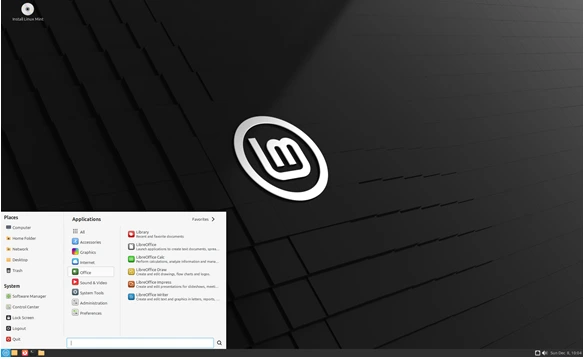
Why Choose Linux Mint?
- Windows-Like UI: The Cinnamon desktop environment mimics Windows 10’s layout, easing the transition.
- Lightweight: Runs efficiently on older hardware with minimal system requirements.
- Privacy-Focused: No telemetry or data tracking, unlike Windows.
- Software: Preinstalled with LibreOffice, VLC, and a software manager for easy app installation.
- Stability: Based on Ubuntu LTS for long-term support.
Drawbacks:
- Similar to Ubuntu, it lacks native support for some Windows-exclusive software.
- Advanced customization requires Linux knowledge.
Who It’s For: Windows 10 users seeking a familiar, lightweight, and free alternative with minimal learning curve.
How to Get Started: Download Linux Mint 22 (Wilma) from the official site. Install via a bootable USB and choose the Cinnamon edition for a Windows-like experience.
4. macOS
Overview: Apple’s macOS, expected to reach version 15 (or 16) by 2025, is a premium OS known for its security, performance, and integration with Apple’s ecosystem.

Why Choose macOS?
- Security: Features strong encryption, app permission management, and M-series chip protections.
- Ecosystem: Seamless integration with iPhone, iPad, and Apple services like iCloud and HomeKit.
- Performance: Optimized for Apple hardware, offering fast boot times and smooth multitasking.
- Creative Tools: Ideal for video editing, graphic design, and music production with apps like Final Cut Pro.
- Privacy: Minimal data collection compared to Windows.
Drawbacks:
- Requires Apple hardware, which is expensive and non-upgradable.
- Limited gaming support compared to Windows.
- Ecosystem lock-in may frustrate non-Apple users.
Who It’s For: Creative professionals, Apple ecosystem users, and those willing to invest in Mac hardware.
How to Get Started: Purchase a MacBook, iMac, or Mac mini with the latest macOS. Used Macs from 2018 or later are viable options for budget-conscious users.
5. ChromeOS Flex
Overview: ChromeOS Flex, developed by Google, transforms older PCs into Chromebook-like devices. It’s lightweight, cloud-focused, and ideal for web-based workflows.

Why Choose ChromeOS Flex?
- Simplicity: Fast boot times and a straightforward interface centered on Google Chrome.
- Cloud-Based: Integrates with Google Workspace, Drive, and web apps.
- Security: Automatic updates and sandboxing protect against malware.
- Cost-Free: Available at no cost, extending the life of old hardware.
- Compatibility: Supports Intel and AMD processors (not ARM).
Drawbacks:
- Limited offline functionality; heavily reliant on internet connectivity.
- Not suitable for resource-intensive tasks like video editing or gaming.
- Incompatible with traditional desktop software.
Who It’s For: Students, educators, and light users who primarily browse the web, use email, or rely on cloud apps.
How to Get Started: Download ChromeOS Flex from Google’s official site, create a bootable USB, and test it on your PC. Check Google’s certified models list for compatibility.
6. Fedora
Overview: Fedora, sponsored by Red Hat, is a cutting-edge Linux distribution known for its modern software and developer-friendly features.
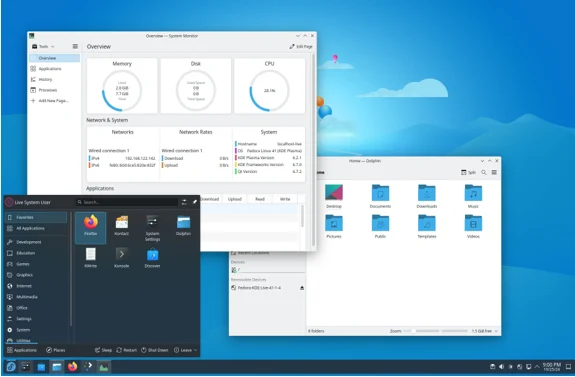
Why Choose Fedora?
- Modern Technology: Ships with the latest Linux kernel, GNOME desktop, and software packages.
- Developer Tools: Ideal for coding, testing, and deploying applications in virtual environments.
- Security: Features SELinux for enhanced protection.
- Community-Driven: Backed by a vibrant open-source community.
- Performance: Optimized for both new and older hardware.
Drawbacks:
- Shorter support cycle (13 months per release) compared to Ubuntu LTS.
- Steeper learning curve for non-technical users.
Who It’s For: Developers, tech enthusiasts, and users comfortable with frequent updates.
How to Get Started: Download Fedora Workstation 42 from the official site. Install via a bootable USB and explore its developer portal for setup guides.
7. Zorin OS
Overview: Zorin OS, based on Ubuntu, is designed as a user-friendly Windows replacement with a customizable interface.
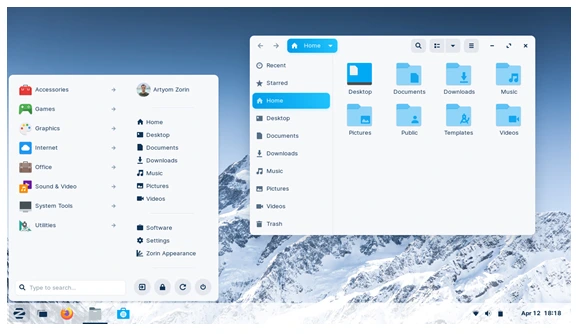
Why Choose Zorin OS?
- Windows-Like Interface: Offers layouts mimicking Windows 10, 11, or macOS.
- Ease of Transition: Includes Wine for running some Windows apps.
- Performance: Fast and lightweight, suitable for older PCs.
- Education Edition: Tailored for schools with educational apps.
- Support: Paid Pro version includes premium features and support.
Drawbacks:
- Some features (e.g., advanced layouts) are locked behind the Pro version ($39).
- Less community support compared to Ubuntu or Mint.
Who It’s For: Windows users seeking a polished, customizable Linux distro with minimal learning curve.
How to Get Started: Download Zorin OS 17.3 (or later) from the official site. Test the free Core version or opt for Pro for additional features.
8. Debian
Overview: Debian is a stable, versatile Linux distribution that serves as the foundation for Ubuntu and Linux Mint. It’s known for its reliability and open-source ethos.
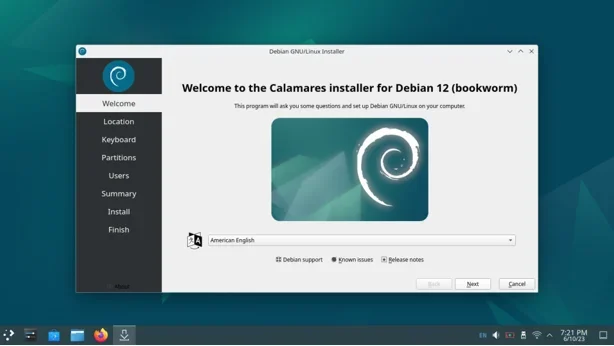
Why Choose Debian?
- Stability: Long-term support releases ensure reliability for years.
- Flexibility: Supports multiple desktop environments (e.g., GNOME, XFCE).
- Free Software: Adheres strictly to open-source principles.
- Community: Backed by a large, dedicated community.
- Compatibility: Runs on a wide range of hardware.
Drawbacks:
- Less user-friendly for beginners compared to Ubuntu or Mint.
- Software packages may be older to prioritize stability.
Who It’s For: Advanced users, server administrators, and open-source purists.How to Get Started: Download Debian 12 (or 13 by 2025) from the official site. Choose the XFCE or GNOME edition for a desktop experience.
9. ReactOS
Overview: ReactOS is an open-source OS designed to be compatible with Windows NT architecture, running some Windows apps and drivers.

Why Choose ReactOS?
- Windows Compatibility: Supports older Windows software and drivers, ideal for legacy applications.
- Free and Open-Source: No licensing fees.
- Lightweight: Runs on minimal hardware, suitable for older PCs.
- Development Potential: Actively developed with improving compatibility.
Drawbacks:
- Still in alpha, with limited stability and compatibility (aims for Windows Server 2003 level).
- Not suitable for gaming or modern software.
- Small community and slower development pace.
Who It’s For: Users with legacy Windows software or those interested in experimental OS projects.
How to Get Started: Download ReactOS 0.4.15 (or later) from the official site. Test in a virtual machine before installing on hardware.
10. Pop!_OS
Overview: Pop!_OS, developed by System76, is a Ubuntu-based Linux distribution tailored for productivity, gaming, and development. It’s gaining popularity for its polished interface and performance.
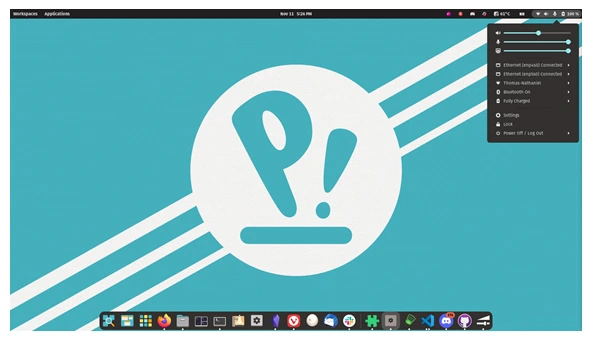
Why Choose Pop!_OS?
- User-Friendly: Features the COSMIC desktop environment (or GNOME) with a streamlined, customizable interface.
- Gaming Support: Preinstalled NVIDIA drivers and Steam compatibility make it a strong Linux gaming platform.
- Developer-Friendly: Includes tools like Docker, Git, and support for multiple programming languages.
- Performance: Optimized for modern and older hardware, with a focus on speed and stability.
- Privacy: No telemetry or data tracking, offering a privacy-focused experience.
Drawbacks:
- Smaller community compared to Ubuntu or Linux Mint, which may limit support resources.
- Some Windows software requires additional setup (e.g., via Wine or virtualization).
- Less beginner-friendly than Linux Mint or Zorin OS.
Who It’s For: Gamers, developers, and users seeking a modern, performance-driven Linux alternative with a balance of ease and power.
How to Get Started: Download Pop!_OS 22.04 LTS (or later) from the official System76 website. Create a bootable USB and choose between Intel/AMD or NVIDIA ISO based on your hardware.
How to Choose the Right Operating System
Selecting the best OS to replace Windows 10 depends on your needs, hardware, and technical expertise. Here’s a quick guide:
For Familiarity: Windows 11 or Linux Mint for a seamless transition.
For Budget: Ubuntu, Linux Mint, ChromeOS Flex, or Debian offer free solutions.
For Privacy: macOS, Ubuntu, or Linux Mint prioritize user data protection.
For Gaming: Windows 11 leads, with Pop!_OS and Ubuntu improving via Steam Proton.
For Developers: Fedora, Pop!_OS, or Debian provide robust tools.
For Legacy Software: ReactOS for older applications.
For Light Use: ChromeOS Flex for web-based tasks.
Pro Tip: Test OSes using Live USB modes or virtual machines (e.g., VirtualBox) before committing to a full installation.
Preparing for the Transition
Switching operating systems requires planning to ensure a smooth experience:
- Back Up Data: Save files to an external drive or cloud service (e.g., Google Drive, OneDrive).
- Check Compatibility: Verify hardware support for the new OS (e.g., ChromeOS Flex’s certified models list).
- Learn the Interface: Explore tutorials or Live Modes to familiarize yourself with the OS.
- Install Software: Identify alternatives for Windows apps (e.g., LibreOffice for Microsoft Office).
- Create a Bootable USB: Use tools like Rufus to prepare installation media.
- Seek Support: Join community forums (e.g., Ubuntu Forums, Reddit) for troubleshooting.
The Future of Operating Systems in 2025
The operating system landscape in 2025 is vibrant, with AI integration, cloud connectivity, and security driving innovation. Windows 12, expected in late 2025, may introduce deeper AI and cloud features, but its hardware requirements could mirror Windows 11’s limitations. Linux distributions are gaining traction, with Ubuntu, Linux Mint, and Pop!_OS leading desktop adoption. ChromeOS Flex is expanding in education, while macOS remains a premium choice for creatives. Niche OSes like ReactOS cater to specific use cases, ensuring no PC is left behind.
Conclusion
As Windows 10’s support ends in October 2025, users have a wealth of alternatives to keep their devices secure and functional. From the familiar Windows 11 to the free and flexible Ubuntu, Linux Mint, and ChromeOS Flex, there’s an OS for every user. macOS offers a premium experience, while Fedora, Zorin OS, Debian, and Pop!_OS cater to enthusiasts, professionals, and gamers. For legacy needs, ReactOS provides a unique solution. By evaluating your needs and testing options, you can confidently transition to a new operating system in 2025, extending the life of your PC and embracing the future of computing.
Ready to make the switch? Share your thoughts in the comments, and let us know which OS you’re choosing to replace Windows 10!
Disclaimer
The information provided in this blog post is for general informational purposes only and is based on data and insights available as of April 21, 2025. While we strive to ensure accuracy by referencing official sources and reputable publications, the operating systems discussed may undergo updates, changes, or discontinuation after publication.
Compatibility, performance, and suitability of any operating system depend on individual hardware, software requirements, and user preferences. We strongly recommend testing operating systems using Live USB modes or virtual machines and backing up all data before making any changes to your system.
The author and publisher are not responsible for any damages, data loss, or issues arising from the use of the information provided. Always consult official documentation or professional IT support for personalized advice before transitioning to a new operating system.
Frequently Asked Questions (FAQs) About Replacing Windows 10 in 2025
What happens when Windows 10 support ends in 2025?
After October 14, 2025, Microsoft will stop providing free security updates and technical support for Windows 10. This leaves devices vulnerable to security risks and compatibility issues. Users can opt for paid Extended Security Updates (ESU) or switch to an alternative operating system like Windows 11, Ubuntu, or Linux Mint to maintain security and functionality.
Which operating system is the best alternative to Windows 10?
The best alternative depends on your needs. Windows 11 is ideal for familiar interfaces and gaming, while Ubuntu and Linux Mint offer free, user-friendly Linux options. ChromeOS Flex suits web-based tasks, and macOS is great for creatives. Pop!_OS is excellent for gaming and development. Test options via Live USB to find the best fit.
Can I run Windows 10 software on Linux-based operating systems?
Some Windows 10 software can run on Linux using compatibility tools like Wine or virtualization software like VirtualBox. However, not all applications (e.g., Adobe or Microsoft Office) are fully compatible. Alternatives like LibreOffice or cloud-based apps can replace many Windows programs on Linux distros like Ubuntu, Linux Mint, or Pop!_OS.
Is it possible to upgrade to Windows 11 if my PC doesn’t meet the requirements?
Windows 11 requires specific hardware (e.g., TPM 2.0, Secure Boot, modern CPUs). If your PC doesn’t meet these, you can’t upgrade officially. Alternatives like Linux Mint, Ubuntu, or ChromeOS Flex are lightweight and compatible with older hardware, extending your device’s life without costly upgrades.
Are free operating systems like Ubuntu and Linux Mint secure?
Yes, free operating systems like Ubuntu, Linux Mint, and Pop!_OS are secure, with frequent updates, minimal bloatware, and no telemetry. They benefit from open-source communities that quickly address vulnerabilities. Always download from official websites and follow best practices, like enabling firewalls and updating regularly, to ensure security.
Also Read
Best Terminal Tools Every Linux User Should Know in 2025

